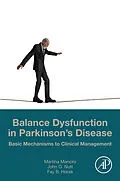Balance Dysfunction in Parkinson's Disease: Basic Mechanisms to Clinical Management presents the most updated information on a variety of topics. Sections help clinicians evaluate the types of balance control issues, dynamic balance dysfunction during turning, and the effects of medication, deep brain stimulation, and rehabilitation intervention on balance control. This book is the first to review the four main postural control systems and how they are affected, including balance during quiet stance, reactive postural adjustments to external perturbations, anticipatory postural adjustments in preparation for voluntary movements, and dynamic balance control during walking and turning. In addition, the book's authors summarize the effects of levodopa, deep brain stimulation, and rehabilitation intervention for each balance domain. This book is recommended for anyone interested in how and why balance control is affected by PD. - Provides the first comprehensive review of research to date on balance dysfunctions in Parkinson's disease - Discusses how to translate current neuroscience research into practice regarding neural control of balance - Provides evidence on the effects of current interventions on balance control
Autorentext
Dr. Mancini received her PhD in bioengineering at University of Bologna in Italy, and completed a postdoctoral fellowship in the Department of Neurology at OHSU. Her translational biomedical research focuses on objectively characterizing, understanding and monitoring mobility impairments in patients with neurological disorders with wearable sensors in order to develop tailored rehabilitation intervention, such as biofeedback-based solutions. She has presented at national and international meetings on topics related to balance and gait impairments in subjects with Parkinson's disease and Parkinsonism, as well as fall risk in healthy elderly subjects. She received an NIH K99-R00 award from the National center for Medical Rehabilitation Research to characterize the physiology of gait disturbances during locomotion with body-worn sensors, and to determine whether vibrotactile biofeedback improves gait disturbances in Parkinson's disease in laboratory and home environments.
Inhalt
1. How is Balance Controlled by the Nervous System? 2. Why is Balance so Important in Parkinson's Disease? 3. How is Balance during Quiet Stance Affected by PD? 4. How are Postural Responses to External Perturbations Affected by PD? 5. How are Anticipatory Postural Adjustments in Preparation for Voluntary Movements Affected by PD? 6. How is Dynamic Balance During Walking Affected by PD? 7. How and Why Is Turning Affected By PD? 8. Is Freezing of Gait a Balance Disorder? 9. How Should the Clinician Approach Imbalance in PD? 10. Future Perspectives on Balance Disorders in PD
